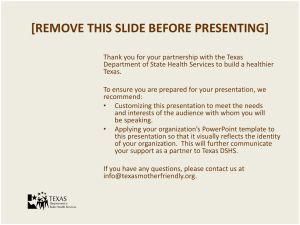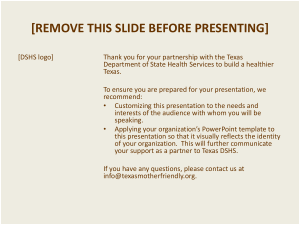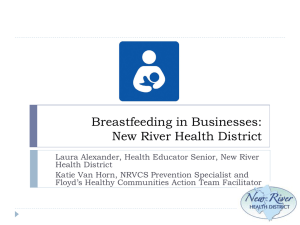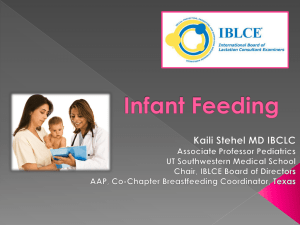PPT 8.09 MB - Mother
advertisement
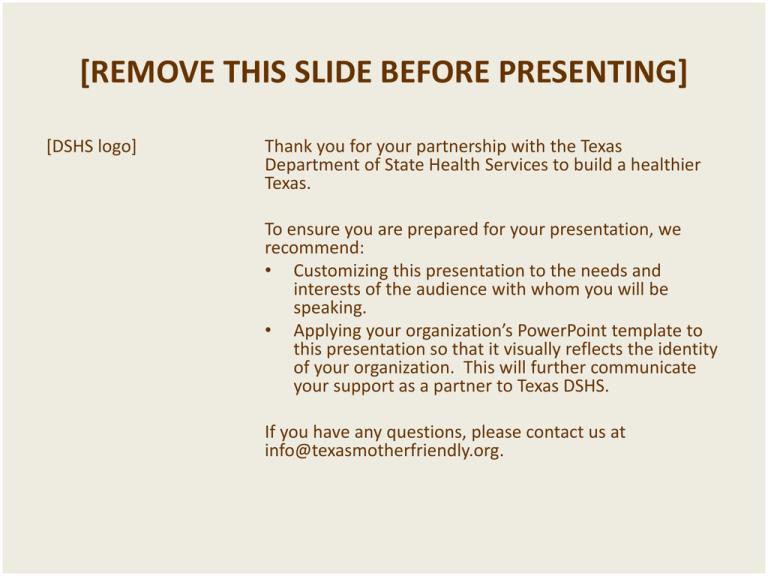
[REMOVE THIS SLIDE BEFORE PRESENTING] [DSHS logo] Thank you for your partnership with the Texas Department of State Health Services to build a healthier Texas. To ensure you are prepared for your presentation, we recommend: • Customizing this presentation to the needs and interests of the audience with whom you will be speaking. • Applying your organization’s PowerPoint template to this presentation so that it visually reflects the identity of your organization. This will further communicate your support as a partner to Texas DSHS. If you have any questions, please contact us at info@texasmotherfriendly.org. [Presenter Name] [Presenter’s title or one-sentence bio] Texas Mother-Friendly Worksite Designation Overview For Managers THE CASE FOR BREASTFEEDING SUPPORT Support of Breastfeeding is a Priority Reduced Risk for Infants with Exclusive Breastfeeding1, 2: • • • • • • • • • • Obesity Ear Infections Respiratory Infections Asthma Gastrointestinal Infections Atopic Dermatitis Type 1 & Type 2 Diabetes Leukemia Sudden Infant Death Syndrome Necrotizing Enterocolitis Public Health Case • Breastfeeding is the standard for infant feeding and protects infants and children from many significant infectious and chronic diseases. • $13 billion of direct pediatric health-care costs and more than 900 lives would be saved annually if 90% of women were able to breastfeed exclusively for six months as recommended.2 • Women who breastfeed have a reduced risk of breast and ovarian cancer, type 2 diabetes, postpartum depression, and cardiovascular disease.3-5 Work Remains a Barrier to Breastfeeding6-10 • Full-time employment decreases breastfeeding duration by an average of more than eight weeks. • Mothers are most likely to wean their infants within the first month after returning to work. • Only 10% of full-time working women exclusively breastfeed for six months. • 58% of new mothers returning to work in Texas are unable to reach their breastfeeding goals. U.S. Women Achieving Personal Breastfeeding Goals Source: Centers for Disease Control and Prevention, 2007 Infant Feeding Practices Survey http://www.cdc.gov/ifps/results/ch3/table3-35.htm Women Need Worksite Lactation Support11 • Breaks for lactation are similar to other work breaks for attending to physical needs: o Time to eat/drink, restroom breaks, accommodation for health needs (e.g., diabetes) • When mother and child are separated for more than a few hours, the woman must express milk. • Missing even one needed pumping session can have undesirable consequences: – – – Discomfort – Leaking – Inflammation Infection – Decreased Milk Production Breastfeeding Cessation How to Support Breastfeeding Employees • In general, women need 30 minutes (15 to 20 minutes for milk expression, plus time to get to and from a private space and to wash hands and equipment) approximately every 2 to 3 hours to express breastmilk or to breastfeed. • Needs may vary from woman to woman and over the course of the breastfeeding period. BENEFITS FOR OUR BUSINESS Business Case11 • Lactation programs are cost-effective, showing a $3 return for every $1 invested. • By supporting lactation at work, employers can reduce turnover, lower recruitment and training costs, cut rates of absenteeism, boost morale and productivity, and reduce health-care costs. • Lactation accommodation is not one-size-fits-all. Flexible programs can be designed to meet the needs of both the employer and employee. Breastfeeding = Increased Productivity11 • Breastfeeding reduces illness of the baby = fewer absences of parent employees = immediate return on investment. • Breastfeeding support in the workplace helps families meet their breastfeeding and childrearing goals = higher job satisfaction, increased loyalty, increased ability to focus on job responsibilities, higher return to work postpartum, and lower turnover = immediate return on investment. • Breastfeeding prevents chronic disease in women who breastfeed and contributes to a healthier future workforce through reduction of obesity and chronic disease = longterm payoff that keeps on giving. Legal Basis Fair Labor Standards Act Section 7 of the Fair Labor Standards Act was amended effective March 2010: Employers are required to provide “reasonable break time for an employee to express breast milk for her nursing child for 1 year after the child’s birth each time such employee has need to express the milk.” Employers are also required to provide “a place, other than a bathroom, that is shielded from view and free from intrusion from coworkers and the public, that may be used by an employee to express breastmilk.” Other Relevant Legal Standards Family Medical Leave Act: Job protection can help women take maternity leave to establish breastfeeding. Texas Health &Safety Code 165: • Affirms a woman’s entitlement to breastfeed in any location in which she “is authorized to be.” • Provides the basis for Texas Department of State Health Services (DSHS) Mother-Friendly Worksite Designation. TEXAS MOTHER-FRIENDLY WORKSITE DESIGNATION Texas Mother-Friendly Worksite Designation Minimum Requirements for Designation: Have a written breastfeeding support policy that provides for: • • • • Flexible scheduling to allow time for the expression of milk. Accessible, private space other than a bathroom (does not need to be a dedicated space). Accessible, clean water source. Accommodation of milk storage (may include mom’s own cooler, employer provided cooler, shared refrigerator space such as in a break room, or a refrigerator dedicated for the purpose of breastmilk storage). TexasMotherFriendly.org Common Concerns of Breastfeeding Mothers11 • Modesty • Time and social constraints • Lack of support • Making enough milk for their babies Definition of Worksite Lactation Support A comprehensive Mother-Friendly program assures: • Support from supervisors, colleagues, and other mothers. • Time to express milk at work and flexible return-to-work options. • Access to education and professional lactation support. • Private space for women to express milk or to breastfeed when they are at work. TexasMotherFriendly.org Program Components11 OUR LACTATION SUPPORT INITIATIVES What do our employees think? Allowing women to take additional unpaid breaks to express/pump milk is fair to me and to my co-workers. What do our employees think? Allowing women to take additional unpaid breaks to express/pump milk will interfere with productivity. What supports do our employees have? What do our nursing employees need? What are our managers concerned about? What do our managers want? Our Policy Insert Policy and Procedures Manager Responsibilities Outline expectations for managers: • Communicate with all employees. • Communicate with employees going on / returning from maternity leave. • Complete required paperwork, if any. Resources What resources are available for managers? • Specific procedures. • Training. • Whom to contact with questions (HR, committee). What resources are available for employees? • Educational materials, professional support. • Whom to contact with questions (HR, committee). References (1-4) 1. Ip S, Chung M, Raman G, Chew P, Magula N, DeVine D, Trikalinos T, Lau J. (Tufts-New England Medical Center Evidence-based Practice Center). Breastfeeding and maternal and infant health outcomes in developed countries. Evidence Report/Technology Assessment No. 153. Rockville, MD: Agency for Healthcare Research and Quality; 2007 Apr. AHRQ Publication No. 07-E007. Contract Nu. 29002-0022. 415 pp. Available from: http://www.ahrq.gov/Clinic/tp/brfouttp.htm 2. American Academy of Pediatrics Section on Breastfeeding. Breastfeeding and the use of human milk. Pediatrics. 2012;129(3):e827-41. 3. Bartick M, Reinhold A. The burden of suboptimal breastfeeding in the in the United States: A pediatric cost analysis. Pediatrics. 2010;125(5): e1048-56. 4. Schwarz EB, Ray RM, Stuebe AM, Allison MA, Ness RB, Freiberg MS, Cauley JA. Duration of lactation and risk factors for maternal cardiovascular disease. Obstet Gynecol. 2009;113(5):974-82. References (5-10) 5. Gunderson EP, Jacobs DR, Chiang V, et al. Duration of lactation and incidence of the metabolic syndrome in women of reproductive age according to gestational diabetes mellitus status: A 20-year prospective study in CARDIA—The Coronary Artery Risk Development in Young Adults Study. Diabetes. 2010;59(2):495-504. 6. Fein B, Roe B. The effect of work status on initiation and duration of breast-feeding. Am J Public Health. 1998:88(7): 1042-46. 7. Cardenas R, Major D. Combining employment and breastfeeding: Utilizing a work-family conflict framework to understand obstacles and solutions. J Bus Psychol. 2005; 20(1): 31-51. 8. Galtry J. Lactation and the labor market: Breastfeeding, labor market changes, and public policy in the United States. Health Care Women Int. 1997;18(5): 467-80. 9. Texas Department of State Health Services. WIC Infant Feeding Practices Survey, 2009. 10. United States Breastfeeding Committee. Workplace Accommodations to Support and Protect Breastfeeding. Washington, DC: United States Breastfeeding Committee; 2010. Available from: http://www.usbreastfeeding.org/Portals/0/Publications/WorkplaceBackground-2010-USBC.pdf References (11-12) 11. Department of Health and Human Services (U.S.). The Business Case for Breastfeeding. Steps for Creating a Breastfeeding Friendly Worksite: Bottom Line Benefits [Kit]. US Department of Health and Human Services, Health Resources and Services Administration (HRSA), Maternal and Child Health Bureau. 2008. HRSA Inventory Code: MCH00254. Available from: http://www.womenshealth.gov/breastfeeding/programs/businesscase/index.cfm 12. US Department of Labor. Break Time for Nursing Mothers. [Online]. 2010. Available from: http://www.dol.gov/whd/nursingmothers/
